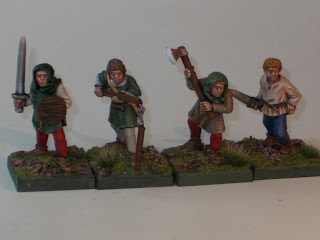This figure bares the arms of Sir William Montagu, alias de Montacute, 2nd
Baron Montacute (c. 1285–1319) and is the first knight I've painted to match
the medieval tiles. His arms, argent three fusils on
fess gules, are quite distinctive.
The Montagu family was an old (probably dating back to the Conquest) West Country family who held lands in Somerset, Dorset and Devon.
Montagu saw service with Edward I during the ongoing wars with Scotland and also went on the serve Edward II. He died in Aquitaine, October 1319, where he had been sent be the court to lessen his influence on the king.
His son, also called William, was created Earl of Salisbury. These arms, quartered with those of Monthermer, would remain visible in various coat of arms including those of Warwick the Kingmaker for years to come.
As you'll be able to tell I'm being quite free and easy with the historical time range with my figures for this onging Cry Havoc project (my toys - my rules). These figures are the first knights to be completed that were inspired by the medieval floor tiles from Shaftesbury abbey, Matching spearmen spearmen (seen in this previous post - Link) will complete the small (tiny actually) retinues.
 |
| Medieval Floor Tile - Shaftesbury abbey |
As the note by the floor tile states:
"It was this Montacute (Montagu) that was in a dispute over the ownership of Sherborne castle in 1341 with Robert Wyville, Bishop of Salisbury, which nearly resulted in a trial by combat."
I will go into more detail about this fascinating 'what if' historical in a future posting i.e. after I've finished painting Montagu's adversary, the Bishop of Salisbury.
 |
| Montagu's (rather small) retinue |
You might have noticed that I haven't painted the horse's caparsion to match the shield. Although this would have been relatively easy to do this figure is a substitute for Sir Gilbert in the Cry Havoc game. This character wears a yellow surcoat and carries a white shield with three red stars (or if you want to be technical - argent, three mullet gules) therefore I decided to mirror the illustration from the game and keep the caparison plain and simple.



















































